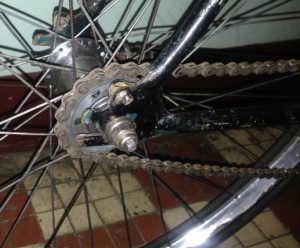Of all the consumables on a bike, the most obscure is the chain. Wear of brake pads, tires or grips is quite noticeable visually, but not everyone can understand when the right moment has come to replace the chain.

Chain wear becomes noticeable only when it leads to wear of the sprockets, due to which gears begin to slip and further cycling becomes impossible. Restoring a bike in such a deplorable state will cost a pretty penny, because you will have to change not only the chain, but also the cassette, front sprockets and rear derailleur rollers. The total amount of repair, of course, will not be comparable to the cost of a new bike, however, all these expenses can be avoided if the chain and cassette are changed in time.
How many kilometers can a bicycle chain last?
Depending on the quality, style and riding areas, a bicycle chain can live from 100 to 5000 km. It is believed that on a mountain bike the chain lives an average of 1000-1200 km, when the specified mileage is reached, it should be replaced with a new one. If you do not drive on the ground and prefer to stay at home in the rain, then the chain life can increase to 2000-2500 km.
Personally, on my bergamon helix 2.4 hybrid bike, the chain lives on average 1500 – 2000 km.
Do not forget that the chain can last much longer if it is properly cleaned and lubricated.
Ways to measure chain wear:
1. Special caliber
To accurately determine the level of chain wear, there are special gauges that show elongation in percent: 0, 0.5, 0.75 or 1.
Using the gauge is the easiest way, just insert it into the chain and see if the gauge falls into the chain or not.
If the gauge does not fit on the side from 0.5 to 0.75, then this means a new chain.
If the caliber falls into the chain from 0.5 to 0.75, this shows that it is time to change the chain.
If the caliber falls into the chain from 0.75 to 1, then most likely the cassette will have to be replaced along with the chain. If the caliber also dangles freely, then in addition to the cassette, the chains will also have to be replaced by the front sprockets, which of course will cost a pretty penny.

There are also more accurate gauges, for example, in the photo above – the blue gauge from Park Tool, it shows a specific chain stretch figure, which of course is more convenient, but I don’t think the average bike lover needs it.
And if there is no caliber, then you can use a caliper or even a regular tape measure.
If there is no caliber, then you can use a caliper or even a regular tape measure.
2. Caliper
We install it on a caliper 119 mm, put it into the chain with internal sponges and push them all the way. Let’s see the result:
- If 119.7 to 120.6 mm is normal wear, chain replacement is not required.
- If from 120.6 to 120.9 mm – a chain replacement is required, a period of running-
- in of the new chain to the old cassette is possible and mutually.
- If more than 120.9 mm – you need to change both the chain and the cassette.
3. Tape measure or ruler
The length of one link of the chain is 0.5 inches, but it is very inconvenient to measure only one link, the length of 24 links (304.8 mm) is usually measured. To measure, remove the chain from the bike and put it on a flat surface, measure 24 links:
- If exactly 304.8 – a new chain.
- If from 304.8 to 306.4 mm – the chain is normal.
- If from 306.4 to 307.9 mm – the chain is worn out. If you replace it now, then at
- first there may be small problems due to a mismatch between the pitch of the new
- chain and the old sprockets. After a while, the chain and sprockets should run in to each other.
If 307.9 mm or more, the chain is badly worn, the cassette and the system, most likely, too. If you replace only the chain, then the running-in process may be delayed. It is better to change the cassette and system along with the chain.
For me, this is the most inconvenient way. I would recommend buying a caliber, since it costs just a penny and monitor the condition of your transmission without any problems.
